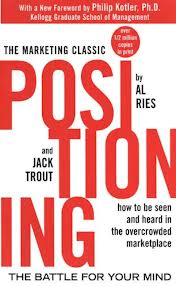Positioning: The Battle for Your Mind

– By Al Ries and Jack Trout
Positioning was published in 1981 and thirty-two years is a long time for any book to become outdated, possibly obsolete. Yet, I would strongly recommend every young marketer to read the book, mainly because the concept of positioning is still very much in practice and it is important to understand its antecedents.
Ries and Trout don’t give an exact definition of positioning in their book. What they highlight are the following:
1. ‘The basic approach of positioning is not to create something new and different. But to manipulate what’s already up there in the mind. To retie the connections that already exist.’
2. ‘But positioning is not what you do to a product. Positioning is what you do to the mind of the prospect. That is, you position the product in the mind of the prospect. So it is incorrect to call the concept ‘product positioning’. As if you were doing something to the product itself.’
3. ‘Positioning is an organized system for finding windows in the mind. It is based on the concept that communication can only take place at the right time and under the right circumstances.’
Ries and Trout argue that well-known products already hold a distinctive position in the consumers’ minds. Thus, Coke is seen by consumers as the world’s largest soft drink brand; Hertz is seen as the world’s largest car rental service; Porsche is seen as the world’s best sports car. These positions are so strong that it would be difficult for competitors to take these companies’ positions head on. Looking at the current well-entrenched consumer perceptions, the options for competitors are the following:
1. Strengthen their own current positioning. An example is Avis which was no.2 to Hertz; Avis realized this handicap and came out with a disarming ad – ‘We are no.2. We try harder’ – that was true to the perception of the brand in the minds of consumers.
2. Grab an uncontested position – look for a hole. American cars were big gas guzzlers and Volkswagen exploited that by positioning their Beetle as the small, fuel-efficient car. Michelob exploited the hole at the premium end of the beer market by positioning itself as a premium brand. Volvo used ‘safety’ as the hole to establish itself as the safest car around.
3. Re-position the competition. Tylenol re-positioned aspirin as the inferior painkiller because of the possibility of aspirin irritating the stomach lining. Stolichnaya re-positioned Smirnoff by stating that while the latter was made in the US, Stolichnaya was made in Russia (the Vodka country).
Ries and Trout also cover the following important topics in the book:
1. The power of the right brand name.
2. The negative aspects of acronyms as brand names.
3. The line-extension trap; that is, hanging an existing name to a new product.
Positioning is replete with examples that were relevant when the book was written. It also has separate chapters on how to position a company, a service, a religious organisation, a country and you! And they offer advice on how to successfully position your brand.
Because positioning has been given no clear definition by Ries and Trout and because other marketing gurus have come out with their own, more precise definitions, I find that many people don’t get the concept of positioning as well as they should. They rely on the one definition that they are familiar with. And that is why the groundbreaking Positioning is such an important book to go through.
I must admit that most of what Ries and Trout covered in Positioning was also covered, fairly consistently, in many of their subsequent books. Yet, do start with Positioning before reading their other books.
Rating: A
